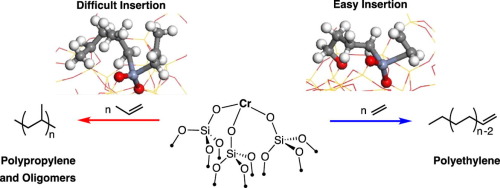Journal of Catalysis ( IF 7.3 ) Pub Date : 2017-09-11 , DOI: 10.1016/j.jcat.2017.08.016 Murielle F. Delley , C.S. Praveen , András P. Borosy , Francisco Núñez-Zarur , Aleix Comas-Vives , Christophe Copéret

|
Silica-supported well-defined Cr(III) sites, which polymerize ethene, are barely reactive towards propene while they copolymerize propene and ethene, a reactivity pattern similar to what is observed for the Phillips catalyst. In contrast to ethene, propene is only polymerized in low amounts and by a small fraction of sites, while during propene/ethene copolymerization small amounts of olefinic oligomers are formed. This difference of reactivity pattern among various olefins is further examined by DFT calculations using periodic amorphous models, focusing on the initiation of polymerization by olefin insertion into the CrO bond vs. the heterolytic C
H activation of the alkene. For both mechanisms, we found that the initial activation displays similar energetics for propene and ethene, while the subsequent propene insertion associated with chain growth becomes rather demanding, which rationalizes the observed difference of reactivity between ethene and propene.
中文翻译:

Cr(III)/ SiO 2上的烯烃聚合:乙烯和丙烯之间反应性差异的机理见解
二氧化硅支撑的,定义明确的Cr(III)位聚合乙烯,在丙烯和乙烯共聚时几乎不对丙烯具有反应性,这种反应性与Phillips催化剂相似。与乙烯相反,丙烯仅以少量和少量位点进行聚合,而在丙烯/乙烯共聚过程中会形成少量的烯烃低聚物。通过使用周期性无定形模型的DFT计算进一步检查了各种烯烃之间反应模式的差异,重点是通过烯烃插入Cr O键相对于杂化C引发的聚合反应
烯烃的H活化。对于这两种机制,我们发现初始活化对丙烯和乙烯显示出相似的能量,而随后与链增长相关的丙烯插入变得相当苛刻,这使观察到的乙烯和丙烯之间的反应性差异合理化。



























 京公网安备 11010802027423号
京公网安备 11010802027423号